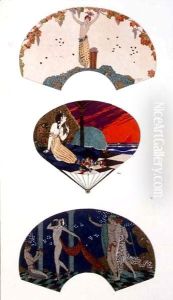Georges & Iribe, Paul Barbier Paintings
Paul Iribe was a notable French illustrator, designer, and decorator, recognized for his significant contributions to the Art Deco movement. Born Paul Iribe on May 8, 1883, in Angoulême, France, he was a pivotal figure in the early 20th century, known for his innovative graphic style and his influence on decorative arts.
After studying at the École des Beaux-Arts in Paris, Iribe gained recognition as an illustrator, working for prominent French magazines such as 'L'Assiette au Beurre' and 'Le Rire'. His illustrations were characterized by a bold, graphic quality that drew on the aesthetics of Art Nouveau but also pointed towards the emerging Art Deco style.
Iribe's work extended beyond illustration as he ventured into decorative arts and design. He collaborated with famed fashion designer Paul Poiret, creating an album of Poiret's designs titled 'Les Robes de Paul Poiret' in 1908, which was a groundbreaking work that fused fashion illustration with fine art. This collaboration was influential in the evolution of fashion illustration and the promotion of the Art Deco aesthetic.
In the 1910s and 1920s, Iribe was active in the film industry in France and then in Hollywood, where he worked as a set and costume designer, further showcasing his versatility and creative vision. His work in the United States included a collaboration with actress and filmmaker Alla Nazimova for the film 'Camille' in 1921.
Iribe's influence extended to furniture and interior design as well. He was known for his luxurious and innovative designs that encapsulated the glamour and modernity of the Art Deco movement. His commitment to craftsmanship and detail was evident in his work, which often featured exotic woods, lacquer, and bold geometric forms.
Despite his success, Iribe's career was cut short when he died at the age of 52 on September 21, 1936. His legacy lives on in the world of design and illustration, where his contributions to the visual language of Art Deco continue to be celebrated.
